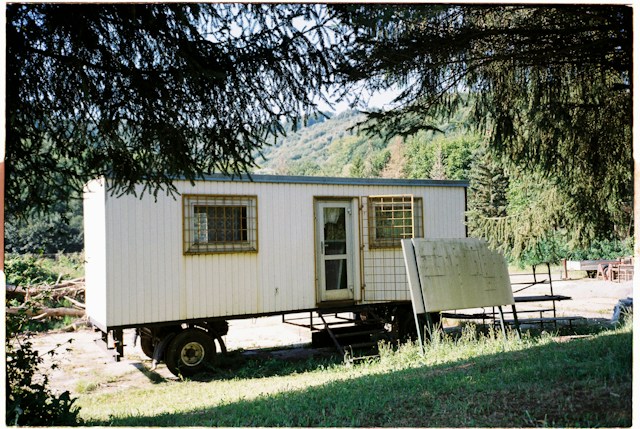Concrete runners play a crucial role in the construction of mobile homes, serving as the backbone of a safe and stable foundation. They are essentially concrete beams that run underneath the home, providing robust support that keeps the structure secure in various weather conditions. Laying a solid foundation with concrete runners can significantly improve the safety and longevity of mobile homes. The merit of a well-built foundation cannot be overstated: offering elevated comfort, preventing structural issues, and increasing the property’s lifespan.
This article will guide you through building concrete runners for a mobile home, providing step-by-step instructions and helpful insights. Read on to learn how to construct a solid foundation supporting your home for years.
What are Concrete Runners For Mobile Homes?
Understanding Concrete Runners
Concrete runners are longitudinal beams made from poured concrete that serve as a solid foundation for mobile homes. They are strategically placed beneath the house, typically running the length of the structure. This provides stability and robust support and significantly improves the home’s resilience against climatic factors such as wind and floods by anchoring it securely to the ground.
The concept of concrete runners is rooted in distributing weight evenly across the structure, reducing the risk of settling or shifting. This evenly distributed support, combined with the toughness and durability of concrete, provides a firm base that increases the home’s stability and longevity. Without a proper foundation that these runners provide, a mobile home can be prone to structural issues, including cracks, warps, and even catastrophic failures. Therefore, concrete runners are a vital part of mobile home construction, ensuring safety and reliability for homeowners.
If you had your mobile home moved for free, it’s possible that the contractor will not include concrete runners but instead use other foundation methods.
Concrete Runners vs. Other Foundation Types
Concrete runners differ notably from other foundation types, primarily due to their design, material, and functionality. While traditional foundations, like slab-on-grade or pier and beam, are rigid and immovable, concrete runners are specifically engineered for mobile homes. They provide the unique flexibility required for such structures while offering a traditional foundation’s strength.
A slab-on-grade foundation, though it offers robust support, doesn’t lend itself well to mobile homes due to its lack of flexibility. It’s a solid, one-piece foundation poured directly on the ground, making it ill-suited for structures that need the ability to shift or move.
Pier and beam foundations, on the other hand, elevate the house off the ground, overcoming some of the limitations of slab-on-grade foundations. However, these foundations require a significant amount of space under the house for optimal performance, which isn’t always feasible in the case of mobile homes.
Concrete runners, in contrast, combine the strength of a slab-on-grade foundation with the flexibility of a pier and beam foundation. This makes them ideal for mobile homes, where stability, resilience, and adaptability are essential. Concrete runners run along the length of the house, providing uniform support across the entire structure. This even distribution of weight prevents the strain on any one part of the building, reducing the risk of structural issues in the long run.
Furthermore, their robust design helps anchor the home securely, safeguarding it against extreme weather conditions. As such, concrete runners offer the best of both worlds, proving to be the most effective foundation solution for mobile homes.
Tools and Materials Required To Build Concrete Runners For Mobile Homes
Because concrete runners are an integral part of a mobile home’s foundation, using the right tools and materials for their construction is essential. There can be no compromise on quality or safety, as these runners will carry the weight of the entire structure. Here’s a list of what you’ll need to build concrete runners for your mobile home:
Concrete mix
First and foremost, you’ll need a high-quality concrete mix to pour the runners. Concrete is known for its strength and durability, making it ideal for mobile home foundations. You can choose between pre-mixed concrete or mixing your own using cement, sand, gravel, and water.
Forms and framing materials
You’ll also need to acquire forms or framing materials for shaping and containing the concrete while it sets. Forms can be made from wood, metal, or even cardboard, depending on your preference and budget. Depending on the size and shape of your runner, you may need several forms. Look for high-quality, sturdy materials that can withstand the pressure and weight of the wet concrete.
Rebar or wire mesh
You must use rebar or wire mesh in your concrete runners for added strength and reinforcement. These materials help prevent the concrete from cracking under pressure and support the structure.
Shovels, wheelbarrows, and trowels
Of course, you’ll need tools for mixing and pouring the concrete into the forms. Shovels will help you move the concrete mix, while wheelbarrows make it easier to transport larger quantities. Trowels are essential for smoothing out the surface of the runners and ensuring a level finish.
Level and measuring tools
You’ll need measuring tools like tape measure, square, and level for accurate and level concrete runners. These will help ensure your forms are correctly placed and the runners are level before the concrete sets. Some additional tools that may be useful are a hammer, saw, and drill.
How To Build Concrete Runners For Mobile Homes
Now that you have all the necessary tools and materials, it’s time to start building your concrete runners. Follow these steps for a successful construction process:
Site preparation and excavation
The first step in building concrete runners for a mobile home is site preparation and excavation, a process that sets the stage for the entire project. This phase is crucial as it ensures the ground is level and stable enough to support the weight of the house.
Clearing the Site
The initial part of site preparation involves clearing the plot where you will set up the mobile home. This involves removing any vegetation, rocks, debris, or other obstructions that might interfere with the construction of the runners. It’s also essential to remove any topsoil, which is typically loose and rich in organic material and thus not ideal for supporting heavy structures.
Marking the Layout
Once you have cleared the site, the next step is to mark out the layout of the runners. This involves taking precise measurements and marking the positions where the runners will be placed. It’s crucial to ensure that the spacing is accurate, as it directly impacts the stability and balance of the mobile home. For example, mobile home steps must be placed precisely to align with the runners.
Excavating the Trenches
With the layout marked, excavation can begin. This entails digging trenches where the concrete runners will be poured. The trenches’ depth and width depend on the mobile home’s size and local building codes. However, they’re typically around a foot wide and several inches deep. Maintaining the level of the trenches is crucial to ensure the runners and, ultimately, the mobile home is level. You will use a builder’s or laser level for this purpose.
Compacting the Soil
After the trenches are dug, compact the soil at the bottom of the trenches. This process involves using a soil compactor or tampers to compress the soil, making it denser and more stable. Compacting the soil reduces the chances of it settling over time, which could cause the concrete runners and the home they support to shift or tilt.
Installing the Formwork
The final step in the site preparation and excavation phase is installing the formwork in the trenches. These forms will shape the concrete runners when the concrete mix is poured in. Ensure the forms are level and secure, as they play a critical role in determining the shape and level of the runners.
Mixing and pouring the concrete
Mixing the Concrete
If you’re using ready-mix concrete, follow the manufacturer’s instructions for mixing. If you’re mixing your own, combine one part cement, two parts sand, and three parts gravel in a large container or wheelbarrow. Gradually add water while mixing until you achieve a thick, paste-like consistency. It’s critical to get the right consistency: too dry, and the concrete will be brittle and weak; too wet, and it can lead to shrinkage or cracking as it dries.
Adding Rebar or Wire Mesh
Before pouring the concrete, place rebar or wire mesh into the forms. This acts as a reinforcement, making the runners stronger and more durable. The rebar or mesh should be evenly spaced and sit approximately in the middle of the depth of the concrete to optimize its reinforcing benefit.
Pouring the Concrete
With the concrete mix ready, pour it into the forms, starting at one end and working your way to the other. Use a shovel or trowel to spread the concrete, ensuring it fills every corner of the form. Tap the sides of the forms with a hammer to release any trapped air bubbles that could weaken the structure.
Leveling the Concrete
After pouring the concrete, use a screed (a long flat board) or a trowel to level off the top of the concrete. Move the screed back and forth across the top of the forms to remove excess concrete and create a smooth, flat surface. It’s crucial to ensure the concrete is level to ensure the mobile home will sit straight on the runners.
Curing and finishing the runners
After pouring and leveling the concrete, it’s time to let the runners cure. This process involves allowing the concrete mix to dry and harden over time, creating a strong, durable foundation for your mobile home.
Covering the Runners
Cover them with plastic sheeting or burlap to prevent unwanted moisture from seeping into the concrete while curing. This helps the concrete retain its moisture, which is crucial for maintaining strength and preventing cracks.
Finishing Touches
After about a week, remove the forms and any excess material from around the runners. With a trowel, smooth out any rough edges or imperfections in the surface of the runners. Finally, add some gravel or landscaping around the runners to prevent erosion and complete the look of your mobile home’s foundation.
Conclusion
Concrete runners are an essential component of mobile home construction, providing stability, durability, and longevity to the structure. Following the steps outlined in this article, you can build solid concrete runners that will support your home for years. So don’t compromise on quality when it comes to your mobile home’s foundation – invest time and effort into building strong concrete runners and enjoy the peace of mind that comes with a solid foundation.



